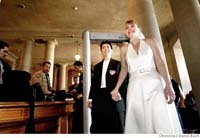South Africa recently joined Canada, the Netherlands, Belgium, and Spain in legalizing gay marriage. How could it be that a state that officially dismantled its Apartheid system a quarter century after the Civil Rights Movement is so far out in front of the U.S. on this issue?
Reflecting on what gives me hope for this struggle in the U.S., I hold a special place in my heart for the day almost three years ago when I witnessed a real-life case of nonviolent civil disobedience. On February 12th, 2004, Mayor Gavin Newsom of San Francisco took affirmative, illegal action just in time for Valentine’s Day. His administration began issuing marriage licenses and performing wedding ceremonies for lesbian and gay couples who waited in long lines at city hall, despite the wishes of voters who had previously passed a proposition banning same sex marriage in California. Never had I imagined that so many smiling, even ecstatic people would have cause to congregate in a government building.
Newsom made a decision to break the law openly, based on a principled position that the law in question is immoral and abhorrent. He wed almost 4,000 couples, and provided momentum for a change in public policy. Since then, the California legislature approved a bill to legalize gay marriage (subsequently vetoed by the Governor). Eventually, I believe the ban will end up in the same rubbish bin as the ban on interracial marriage. A majority of US citizens age 18-29 support lesbian and gay marriage, compared to only 32% of those over age 30. As the younger generation passes on this tolerance to their children, the prejudice is likely to disappear.
The idea that all laws are somehow “right” or “moral” is, if we pause to think about it, preposterous. People have suffered under plenty of laws that were eventually exposed as oppressive and immoral, from slavery to segregation to the denial of women’s rights. In many such cases, the majority of citizens were blinded by fear and prejudice, and it took a small, courageous minority to expose the truth for all to see.
So what is going on when someone decides to commit civil disobedience in open defiance of a law they consider unjust? Gandhi would call this an act of searching for or “holding fast” to truth – what he labeled Satyagraha. Usually, Satyagraha is understood to involve the acceptance of self-suffering in order to reach the heart of the oppressor. Although there are certainly cases where it’s necessary to be willing to take on such suffering (and the strict definition of civil disobedience requires “accepting the consequences of one’s actions”), in this case perhaps it wasn’t necessary. Newsom was able to continue his action for a month before the Governor finally threatened to shut the party down by force. Newsom’s choice to back off when he did might have lessened the potential of his actions to embarass the Governor or turn the action into a power struggle, and thus, from a principled point of view, may have been quite wise. By stepping back, Newsom created the space for the legislature and court system to weigh in on the issue.
What Newsom did took courage – none of the national leaders in his political party supported the move at the time, denouncing it as endangering their chances of winning the Presidential election. This makes the action all the more significant, as it was clear from Newsom’s statements that it was a choice made out of conviction, a response to the President’s anti-gay comments earlier that year.
Newsom said at the time, “California's Constitution leaves no doubts. It leaves no room for any form of discrimination… A barrier to true justice has been removed.” (Disclosure: None of my comments should be taken as an endorsement of Newsom. In fact, I canvassed for one of his opponents, and would do so again.)
People who are uncomfortable with gay marriage may react to this article with concerns like, “There’s no biological/reproductive basis for gay marriage,” or “that’s not how our society is structured.” The point of this article is not to debate the merits of gay marriage, but to examine the dynamics of nonviolent civil disobedience in the context of a struggle for truth and justice. Melanie Judge, program manager for OUT, a gay rights advocacy group, had this to say about South Africa’s recent ruling: “What does equality really mean? What does it look like? Equality does not exist on a sliding scale.”
In standing with LGBT organizations such as Marriage Equality USA and Soul Force (the latter practices “relentless nonviolent resistance”), Newsom did something concrete to represent a simple truth. He exposed the lie of homophobia in a creative, constructive, and dignified manner. It seems to me that the question about gay marriage ultimately is one about whether or not it’s “okay to be gay” in the same sense that “it’s okay to be straight.” When pictures of the happy couples showed up on the front pages of national newspapers, how could they be viewed as anything but the beautiful human beings they are?
Marriage Equality USA: http://www.marriageequality.org
Soul Force: http://www.soulforce.org
San Francisco Chronicle report: http://tinyurl.com/vgvv3


